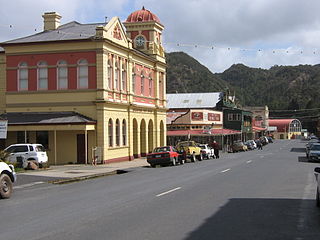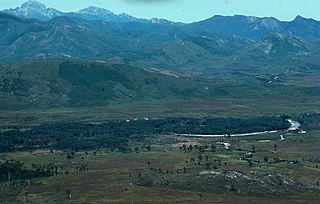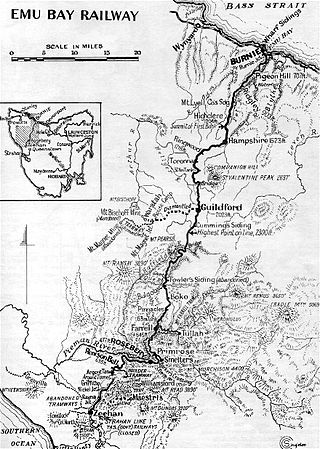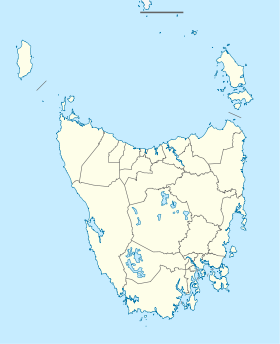
Queenstown is a town in the West Coast region of the island of Tasmania, Australia. It is in a valley on the western slopes of Mount Owen on the West Coast Range.
The history of Tasmania begins at the end of the Last Glacial Period when it is believed that the island was joined to the Australian mainland. Little is known of the human history of the island until the British colonisation of Tasmania in the 19th century.

The King River is a major perennial river in the West Coast region of Tasmania, Australia.

Zeehan is a town on the west coast of Tasmania, Australia 139 kilometres (86 mi) south-west of Burnie. It is part of the West Coast Council, along with the seaport Strahan and neighbouring mining towns of Rosebery and Queenstown.
Mount Lyell Mining and Railway Company was a Tasmanian mining company formed on 29 March 1893, most commonly referred to as Mount Lyell. Mount Lyell was the dominant copper mining company of the West Coast from 1893 to 1994, and was based in Queenstown, Tasmania.

The Melba Line is a 1,067 mm narrow-gauge railway on the West Coast of Tasmania. The line was originally constructed as a private railway line named the Emu Bay Railway and was one of the longest-lasting and most successful private railway companies in Australia. While at present the line travels from Burnie to Melba Flats, it previously ran through to Zeehan carrying minerals and passengers as an essential service for the West Coast community.
Renison Bell is an underground tin mine and locality on the West Coast of Tasmania, Australia.
Mount Read is a mountain located in the West Coast region of Tasmania, Australia, and is at the north west edge of the West Coast Range.
The mines of the West Coast of Tasmania have a rich historical heritage as well as an important mineralogical value in containing or having had found, specimens of rare and unusual minerals. Also, the various mining fields have important roles in the understanding of the mineralization of the Mount Read Volcanics, and the occurrence of economic minerals.
William Harper Twelvetrees was an English geologist who was important for the characterisation of the geology of Tasmania.

Waratah is a locality and town in North Western Tasmania adjacent to Savage River National Park. The town was constructed to support a tin mine at Mount Bischoff. It is built at the top of a waterfall, and water was diverted from the stream to provide water for mine sluicing and processing. At the 2021 census, Waratah had a population of 249. It was also the first town in Australia to have electric street lights in 1886.
The Moorina Power Station is a decommissioned hydroelectric power station, located near the hamlet of Moorina in far north-eastern Tasmania, Australia. Opened in 1909 and decommissioned in 2008, at the time of its closure, Moorina Power Station was the oldest operating electricity generator in Australia.
James (Philosopher) Smith was a politician, goldminer, explorer and discoverer of tin reserves in Tasmania, Australia including the Mount Bischoff mine.
The Anthony Power Development Scheme, part of the Pieman River power development scheme, was a proposed scheme for damming parts of the upper catchment of the Pieman River in Western Tasmania, Australia.

John Dunlop Millen was an Australian engineer and politician. He served as a Senator for Tasmania from 1920 to 1938, representing the Nationalist Party until 1931 and then the United Australia Party (UAP). He managed the Mount Bischoff tin mine before entering politics and served a term as president of the Institution of Engineers, Australia.

The Emu Bay Railway was a Tasmania, Australian railway company. The railway was significant during full operation, in that it linked the Tasmanian Government Railways system at Burnie with that at Zeehan that further linked to the Mount Lyell railway allowing connection through to Queenstown.
Moina is a town 45 km inland from Devonport on the north-west coast of Tasmania, Australia. Moina was the site of a brief gold rush in the late nineteenth century and then one of the largest wolfram and bismuth mines in Tasmania. It has been the centre of continued mineral exploration in the Middlesex district since the first discoveries of tin and tungsten ores on Dolcoath Hill in the 1890s. The name may be a derivation of a small crustacean of the same name found in Tasmanian waters.
Mount Magnet silver mine, also known as the Magnet Silver Mining Company operated between 1902 and 1941.

Heinrich Wilhelm Ferdinand "Ferd" Kayser, was the mine manager of Mount Bischoff Tin Mining Company for thirty years.
The Tamar Hematite Iron Company (THIC) was an iron mining and smelting company that operated from April 1874 to December 1877, in the area close to the location of the modern-day township of Beaconsfield, Tasmania, Australia.









